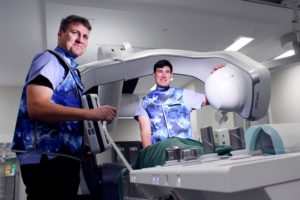World First LARK Study Targets Liver Cancer

With every millimetre counting in radiation therapy treatment, a new world first study developed in Australia could eventually benefit cancer patients across the world.
The Liver Ablative Radiotherapy with KIM (LARK) clinical trial, which has received $583,000 from the Cancer Australia Funding program, will assess the effectiveness of Kilovoltage Intrafraction Monitoring (KIM) in 46 liver cancer patients. If successful, this could change the standard way to treat liver cancer in the future.
Through KIM, patients could benefit from further improved Stereotactic Ablative Body Radiotherapy (SABR) treatment and have their cancerous tumours targeted more accurately and effectively.
Prof Paul Keall, who has helped devise the program, said the trials could also lead to reduced side effects for patients, lead to treatment for other cancers and potentially help prolong and save lives.
“At the moment, imaging is only performed prior to treatment and the cancer target motion during treatment is unknown,” Prof Keall said. “Tumour motion during radiotherapy causes reduced patient dose distribution accuracy and inferior patient outcomes.
“We hope we can show the process (of treatment) can be more efficient and improved in terms of accuracy and lead to better patient outcomes.”
Liver cancer is one of the deadliest forms of cancer, with only about 10 per cent of patients surviving for at least five years after diagnosis.
Trials of SABR have shown promising results for patients in terms of better quality of life and reducing the spread of their cancer.
In standard liver cancer SABR treatment, clinicians have to routinely add up to two centimetres of extra margins around the identified tumour to allow for the tumour motion – thereby treating areas that are not cancerous. KIM allows clinicians to track more precisely how a tumour has moved and then target it more accurately with the beams from SABR treatment.
“When a person breathes, their diaphragm moves,” Prof Keall, who is based at the Australian Cancer Research Foundation Image X Institute, said. “In the same way, when a patient breathes, their tumour also moves as well.
“Through successful use of KIM, we will be confident that we are accurately measuring the cancer targeting ability of the treatment, the dose (of radiation therapy) being administered to both patients and the tumour and therefore reducing the side effects of the treatment.
“Liver cancer is a tough disease to treat, so using advanced technologies to hopefully help future treatment is an exciting development.”

Prof Paul Keall (left), pictured here with Prof Ricky O”Brien (also from the ACRF Image Institute), is excited for the progress of the world-first LARK program.
Prof Keall said this treatment, which also has potential use for patients suffering abdomen, thorax and pelvic cancer, ‘piggybacked’ on similar methods used in the earlier SPARK trial for prostate cancer patients.
Success of this trial will lead to the use of KIM for liver cancer patients worldwide and also stimulate trials for lung, kidney and pancreas cancer.
Prof Keall said he expected the first of the selected patients to be treated in the next few months.
The trial will be co-ordinated by the Trans-Tasman Radiation Oncology Group, with its findings monitored over the next two years.
“Receiving the grant is an excellent team accomplishment,” Prof Keall said. “Sharing the impacts of new technologies and research with patients is the most satisfying part of what we do.
“We are delighted and humbled to receive this funding.”
For more information on the LARK trial, click here.
For more information on how radiation therapy can help treat cancer, click here.



